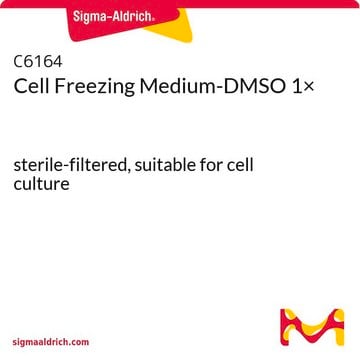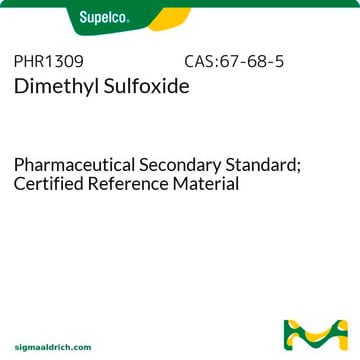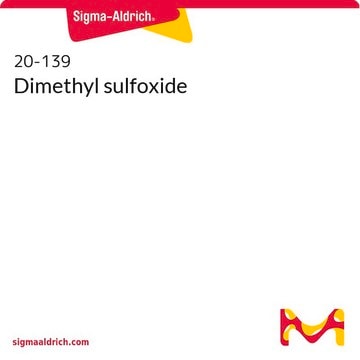Both D2438 and D2650 are suitable for cell culture. The D2650 is part of the Hybri-Max™ product line. Hybri-Max products have been tested for use in hybridoma creation and culture. The D2438 is part of the BioPerformance Certified group of products. These products are tested and optimized for use in biological applications. For this product and a number of others, this includes testing to meet USP and EP guidelines. Please see the links below to review a sample Certificate of Analysis for each item.
D2650
https://www.sigmaaldrich.com/product/sigma/d2438#product-documentation
D2438
https://www.sigmaaldrich.com/product/sigma/d2650#product-documentation
D2438
Diméthylsulfoxyde
sterile-filtered, BioPerformance Certified, meets EP, USP testing specifications, suitable for hybridoma
Synonyme(s) :
DMSO, Sulfoxyde de méthyle
Sélectionner une taille de conditionnement
200.00 CHF
Date d'expédition estimée le27 mars 2025
Sélectionner une taille de conditionnement
About This Item
cryopreservation: suitable
200.00 CHF
Date d'expédition estimée le27 mars 2025
Produits recommandés
Qualité
BioPerformance Certified
Niveau de qualité
Agence
USP XXIV
meets EP testing specifications
meets USP testing specifications
Densité de vapeur
2.7 (vs air)
Pression de vapeur
0.42 mmHg ( 20 °C)
Stérilité
sterile-filtered
Forme
liquid
Température d'inflammation spontanée
573 °F
Limite d'explosivité
42 %, 63 °F
Technique(s)
cell culture | hybridoma: suitable
cryopreservation: suitable
Impuretés
≤0.1% water
Couleur
colorless
Indice de réfraction
n20/D 1.479 (lit.)
pb
189 °C (lit.)
Pf
16-19 °C (lit.)
Solubilité
H2O: miscible (completely)
Densité
1.10 g/mL (lit.)
Chaîne SMILES
CS(C)=O
InChI
1S/C2H6OS/c1-4(2)3/h1-2H3
Clé InChI
IAZDPXIOMUYVGZ-UHFFFAOYSA-N
Vous recherchez des produits similaires ? Visite Guide de comparaison des produits
Description générale
Application
Caractéristiques et avantages
Attention
Code de la classe de stockage
10 - Combustible liquids
Classe de danger pour l'eau (WGK)
WGK 1
Point d'éclair (°F)
188.6 °F - closed cup
Point d'éclair (°C)
87 °C - closed cup
Équipement de protection individuelle
Eyeshields, Gloves, type ABEK (EN14387) respirator filter
Faites votre choix parmi les versions les plus récentes :
Déjà en possession de ce produit ?
Retrouvez la documentation relative aux produits que vous avez récemment achetés dans la Bibliothèque de documents.
Les clients ont également consulté
Articles
Overview of good cell banking practices for cell line cryopreservation purposes.
-
Hi, what is the difference between DMSO product# D2438 and D2650? What is Hybri-Max vs. BioPerformance certified and meets USP testing specification?
1 answer-
Helpful?
-
-
Purity grade of the product ?
1 answer-
The purity of this product is listed on the lot specific Certificate of Analysis. Please navigate to the DOCUMENTATION section of the Product Detail Page to access a Certificate:
https://www.sigmaaldrich.com/product/sigma/d2438#product-documentationHelpful?
-
-
El DMSO es sensible a la luz, hay que tomar alguna precaución al respecto?
1 answer-
This product is packaged in amber glass and is protected from light. The 10 mL size is packaged in a sealed ampule. Once opened, any content that is not used should also be stored in amber glass. For long term storage, the material may also be stored under inert gas to preserve the shelf life. Note that this material has a tendency to absorb water. Containers should be tightly sealed.
Helpful?
-
-
what are the storing conditions?
1 answer-
This product is stored at room temperature. Store in a well-ventilated place. Keep cool. Please see the Material Safety Data Sheet for more information: https://www.sigmaaldrich.com/sds/sigma/d2438.
Helpful?
-
-
What is the difference between products D2438 and D8418?
1 answer-
The D2438 is a BioPerformance Certified grade product suitable for cell culture, hybridoma creation, and cryopreservation. It is intended for research use only but does meet USP and EP testing requirements. The D8418 is a molecular biology-grade product suitable for DNA sequencing, PCR, and transfection. It has been tested for RNAse and DNAse. The products can be selected based on the application.
Please view the sample Certificate of Analysis for each product to see the testing specifications associated with that item:
https://www.sigmaaldrich.com/certificates/Graphics/COfAInfo/fluka/pdf/PDF734068.pdf
https://www.sigmaaldrich.com/coa/SIGMA/D2438/RNBL8837Helpful?
-
-
What is the basis for the endotoxin specification for Dimethyl sulfoxide (DMSO)?
1 answer-
The industry standard for 'endotoxin free' is less than 1 EU/mL.
Helpful?
-
-
What type of filter is used to sterile-filter Dimethyl sulfoxide (DMSO)?
1 answer-
DMSO can be sterile-filtered through a 0.2 micron PTFE filter. The sterility testing is per the current US Pharmacopoeia method.
Helpful?
-
-
What concentration of DMSO do I use in a cell freezing media?
1 answer-
DMSO is usually used at 1-10%, depending on the cell line. For the cell freezing media that we offer, it is used at 8.7% concentration.
Helpful?
-
-
What is the molarity of DMSO?
1 answer-
DMSO will have a molarity of 14.1M, based on a density of 1.1 g/mL and a molecular weight of 78.13 g/mol.
Helpful?
-
-
Dimethyl sulfoxide (DMSO) should be a liquid. Why did it arrive as a solid?
1 answer-
DMSO supercools easily, and re-melts slowly at room temperature. The melting point is 16-19 °C. The solidified product can be re-liquefied by warming to room temperature without detriment to the product.
Helpful?
-
Active Filters
Notre équipe de scientifiques dispose d'une expérience dans tous les secteurs de la recherche, notamment en sciences de la vie, science des matériaux, synthèse chimique, chromatographie, analyse et dans de nombreux autres domaines..
Contacter notre Service technique






